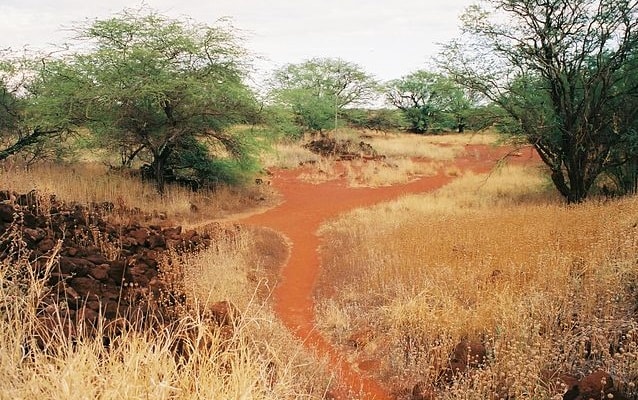Last updated: August 16, 2019
Place
Russian Fort/ Fort Elizabeth

Photo by Mel29, CC0
Russian Fort, located in Fort Elizabeth State Historical Park in Waimea on the Island of Kauai, was built at the prompting of the Russian American Company (RAC) in 1817. The original purpose of the fort was to establish a foothold for Russia in Hawaii by creating a fueling station in the Pacific Ocean and as a stable trading location for the shipping company. The fort is a reminder of the short Russian venture into Hawaii between 1815 and 1817. Following its dissolution, the fort housed Hawaiian soldiers for more than forty years. The native Hawaiian name for the fort is Pāʻulaʻula.
The governor of the Russian Trading Company, located in Sitka, Alaska, wanted to procure food from Hawaii for the Alaska settlements and to resupply RAC ships on longer voyages across the Pacific Ocean. In 1815, the RAC ship Bering wrecked near Waimea, and Kaumualiʻi, ali'i 'ai moku (paramount chief) of Kauai, seized the ship's cargo. The following year Dr. Georg Anton Schäffer of Germany, a physician and agent of the RAC, was sent by the company to Hawaii to retrieve the remaining contents of the ship and seek compensation for any lost cargo.
Dr. Schäffer's orders were to first befriend King Kamehameha I, who had united all of the Hawaiian Islands into the Kingdom of Hawai'i, and then to gain his support in recovering the seized cargo from Kamehameha's rival Kaumualiʻi. If successful, Schäffer was directed to ask for compensation in sandalwood for the remaining value of the Bering's cargo. After that, he was to discuss a sandalwood monopoly trade agreement between the RAC and the Kingdom of Hawai'i. Either way, with or without Kamehameha's help, Schäffer was ordered to retrieve whatever remained of the Bering's cargo and to recover the cost from Kaumualiʻi for whatever had been lost.
Schäffer attempted to carry out his orders and even treated Kamehameha and one of his wives for medical ailments, which gained Kamehameha's respect. Kamehameha chose to progress slowly in trade negotiations, however, and also declined to help the doctor in his dealings with Kaumualiʻi. Schäffer became frustrated with the speed of the negotiations, and decided to travel to the island of Kauai on his own.
Schäffer's visit to Kauai quickly deviated from his original orders. He worked to befriend Kaumuali'i and instead of merely obtaining compensation from him for the Bering and establishing trade relations, Schäffer went further. He negotiated for return of the Bering's cargo and compensation plus an agreement for the RAC that involved becoming the protectorate of all of the islands Kaumuali'i claimed as his—Kauai, Niihau, Oahu, and Maui—in exchange for helping Kaumuali'i acquire additional islands and territories. The agreement also included a sandalwood monopoly for the RAC and a commitment by the Russians to assist Kaumuali'i with any conflicts he had with Kamehameha. While Kaumualiʻi had pledged allegiance to Kamehameha in 1810 and seemingly accepted his rule over all of the islands, he never really intended to give up Kauai and believed he could reclaim and expand his own kingdom with Russia's help. Dr. Schäffer agreed to this treaty and quickly sent word to both the RAC office and the Russian government in St. Petersburg about his diplomatic success.
Utilizing a design by Dr. Schäffer, Hawaiian workers under the direction of Kaumualiʻi constructed a fortified complex on the east bank of the Waimea River that, for a time, flew the Russian flag. Known as Fort Elizabeth, it was a blend of European military architecture and Hawaiian building materials. The fort was constructed with star-like projections common in early 19th-century European forts, but utilized Hawaiian materials including rocks from a former heiau (place of worship) in the construction of the walls. The fort's shape was an uneven octagon 300 feet by 400 feet, with 20-foot high walls that varied in width from 25 to 40 feet.
While the fort was still under construction, Dr. Schäffer received news that the Russian government rejected the treaty he had negotiated with Kaumuali'i. The Russians did not want to defend the islands controlled by Kaumuali'i from both Kamehameha and the American sailors and missionaries who had established a favorable relationship with the King and his government. Instead, the Russian government informed Dr. Schäffer that he had overstepped his responsibilities. This news spread quickly, forcing Schäffer to flee the island before being attacked. He made his way to Russia where he was removed from his job and sent back to Germany.
Kaumuali'i's troops maintained use of the fort long after Schäffer’s departure. One notable event for the fort after 1817 was the 21-gun salute fired from it in 1820 when Kaumaull'i's son returned home on the American Brig Thaddeus from school in the U.S. The fort was eventually acquired by the Hawaiian government for its military, but was dismantled in 1864.
The Russian Fort is a reminder of the brief Russian presence in Hawaii. The outer stacked stone walls of the fort remain and on the inside are the foundations of the magazine and other buildings. Visitors can enjoy the seascape views, a walking tour, and use images at the site to imagine what the complex looked like in the 19th century.
Citations:
Mills, Peter R. 2002. Hawaiiʻs Russian Adventure: A New Look at Old History. Honolulu, University of Hawaii Press.
